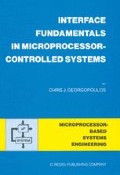Abstract
The interest in adapting fiber optic (F0) data links to a broad spectrum of applications, ranging from measurements instrumentation and local data couuuunications to long-distance telephone communications, is continuously increasing. This high interest results from the advantages that optical fibers have over metallic conductors for transmitting information. The advantages depend on the application but include the following :
-
Immunity from electromagnetic interference
-
No electromagnetic emission
-
Freedom from ground loops
-
Smaller cable size and weight
-
Higher bandwidth
-
Longer link length without repeaters
-
Potentially lower cost in volume production.
Access this chapter
Tax calculation will be finalised at checkout
Purchases are for personal use only
Preview
Unable to display preview. Download preview PDF.
References
Cited References
J. McDermott, “Fiber Optics-They’re Here: Interconnections for Computers and Instrumentation,” Electronic Design 22, pp.67–71, October 25, 1978.
C.J. Georgopoulos, “The Fiber Optics in Computer Communications,” Proceedings of 282 Congresso Scientifico Internazionale per L’ EZectronica, pp.188–193, Palazzo Dei Congressi,Italy, March 23–25, 1981.
E. Randall and R. Lavelle, “Optimize Optical Modem Cost/Performance Through Emitter, Detector and Fiber Selection,” Electronic Design 8, pp.126–127, April 12, 1980.
C. Ovrén, M. Adolfsson and B. Hök, “Fiber-Optic Systems for Temperature and Vibration Measurements in Industrial Applications,” International Conference on Optical Techniques in Process Control, pp.6781, The Hague, The Netherlands, June 14–16, 1983.
R. Allan, “Fiber-Optic Multiplexer for Factory Networks Mixes Fast Analog-Digital Signals,” Electronic Design, p.72E, November 24, 1983.
E.G. Tiedeman, Jr., and M.M. Colavita, “A Microprocessor Controlled Fiber Optic Voice and Data Link,” International Conference on Communications, Boston, MA, June 10–13, 1979.
S. Adlerstein, “Communications Getting a Double Boost:uP-Controlled Fiber Optics,” Electronic Design 11, pp.36–37, May 24, 1979.
E. Hornung, “Fiber Optic Distributed Process Control System,” FOC/ LAN 83, p.262, Atlantic City, N.J., October 10–14, 1983.
P.J. Coen and M.S.Cole, “Slotted Ring Local Area Network Systems,” FOC/LAN 83, pp.43–46, Atlantic City, N.J., October 10–14, 1983.
L. Yencharis, “Local-Area Networks Work as Fast as 100Mbits/s Over Optical Links,” Electronic Design, p.31, April 30, 1981.
D.B. Brick, “Overview of Fiber Optic Local and Wide Area Networks,” Mini/Micro Northeast/84, Computer Conference and Exhibition, pp.9/1. 1–9/1.5, Boston, MA, May 15–17, 1984.
S. Joshi and V. Iyer, “New Standards for Local Networks Push Upper Limits for Lightwave Data,” Data Communications, p. 127, July 1984.
Y. Tekeshige, “NEC’s C & C-NET Approach to Optical Networks,” JEE, p. 58, August 1983.
T. Kunihero, “Fiber-Optic Local Network Sets Its Sights on Offices and Factories,” Electronics, pp.125–128, July 28, 1983.
General References
P. Bocqueho and B. Desert, Experimental F-0 Teledistribution Network; Telecommunications, p. 87–1, July 1984.
C.J. Georgopoulos, “Intercom System With Fiber Optic Ring Bus and Internal Repeaters,” FOC/LAN 83, Atlantic City, NJ, October 10–14, 1983.
C.J. Georgopoulos, Fiber Optics and Optical Isolators, Gainesville, Virginia: DWCI, 1982.
C. Baak, et al., “A Fiber-Optic Broad-Band Integrated Services Network for the Subscriber Area,” ECOC 83, Geneva, Switzerland, October 23–26, 1983.
T. Kihara, et al.,“Optical Data-Transmission Equipment for Computer Systems (Optical Data Mux),” National Telecommunications Conference, New Orleans, LA, Nov. 29-Dec. 3, 1981.
P.E. Green, Jr., “Progress in Fiber Optics, LANs, and PABXs,” IEEE spectrum, pp. 38–39, January 1985.
Author information
Authors and Affiliations
Rights and permissions
Copyright information
© 1985 D. Reidel Publishing Company, Dordrecht, Holland
About this chapter
Cite this chapter
Georgopoulos, C.J. (1985). Interfaces for μP- Controlled Fiber Optic Systems. In: Interface Fundamentals in Microprocessor-Controlled Systems. International Series on Microprocessor-Based Systems Engineering, vol 3. Springer, Dordrecht. https://doi.org/10.1007/978-94-009-5470-0_15
Download citation
DOI: https://doi.org/10.1007/978-94-009-5470-0_15
Publisher Name: Springer, Dordrecht
Print ISBN: 978-94-010-8915-9
Online ISBN: 978-94-009-5470-0
eBook Packages: Springer Book Archive

